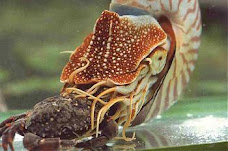1. Shigeno, S., Takenori S., Takeya M. et al. 2007. Evolution of the cephalopod head complex by assembly of multiple molluscan body parts: Evidence from Nautilus embryonic development. (Nautiloidea:Nautilida:Nautilina:Nautilidae). Journal of Morphology. Published online 07.24.2007. PMID: 17654542.
- Can certain primitive features in embryonic stages of Nautilus pompilius propose an alternative scheme for the evolution of cephalopod body plans, specifically of the morphology of the head parts? Previous evolutionary hypotheses have been proposed on the basis of combined embryological and paleontological observations as they tend to contrast. The recent onset of studies on the morphology of Nautilus embryos offered a new opportunity to test these hypotheses. as differences in Nautilus and coleiod cephalopod embryos were noted.
- The evolution of the head complex, or the complicated incorporation of many long tentacles or arms, cupshaped eyes, statocysts, sense organs, a centralized brain and funnel in the cephalopod head, is intriguing as it seems to represent the pivotal transition from benthos to nekton. Because embryological hypotheses were previously based on coleiod cephalopods, the opportunity to study Nautilus embryology would test the universality of such hypotheses. Although there were no previous studies to suggest Nautilus embryology would be more informative of the evolution of the cephalopod head complex to date, the fact its embryology was preliminarily different than of coleiods suggested it might be.
- Embryos of both Nautilus pompilius and of the already-studied Idiosepius paradoxus squid were compared. The results demonstrated, among many things, that 1) the distinct cephalic compartment, foot, brain cords, mantle, and shell resembled the body
plans of monoplacophorans and basal gastropods, 2) origins of digital tentacles or arms of all other cephalopods develop not from the head but from the foot, silencing previous debates and that 3) formation of a ‘‘head complex" assembled in mid to late embryos when the primary body plans changed. - This was the first evidence from embryology that the morphological development of the head complex was via the assembly of multiple archetypical molluscan body parts and support that this assembly was based on transitional niche ecology.
2. Ward, P.D., Saunders, W.B. 1997. Allonautilus: A new genus of living nautiloid cephalopod and its bearing on phylogeny of the Nautilida. (Nautiloidea:Nautilida:Nautilina:Nautilidae). Journal of Paleontology. 17: 1054-1064.
- Will soft-, as well as hard-part anatomy differ in the currently defined species of Nautilus and what light can morphological data shed on the phylogeny as opposed to genetic?Previous studies were based solely on genetic data, and had concluded that N. scrobiculatus was so distinct from the rest of the Nautilus genus that it should be separated into two unifying taxa.
- A century and a half has passed that shell shape and colouration have been known to be different in N. scrobiculatus and the rarely discussed N. perforatus but their distinction was never formalized. Now that unambiguous soft-part observations can be made across three extant and numerous species of the genus, they may depict an intirely new phylogeny.
- N. scrobiculatus, N. pompilius, N. belauensis were used for comparison of gross anatomy and male reproductive system while comparisons of gross shell morphology was referenced. Extinct species of N. cookanum and other outgroup nautilacean fossils were also examined. In total there were 30 character sets on which to determine philogeny twenty of which were informative. The cladistic analysis sucessfully distinguished N. scrobiculatus from N. perforatus as two separate species deserving of a seperate genus from the rest of the extant Nautilus species. Fossil records suggested that these two species are dervied from the Nautilus genus.
- These findings lead Ward et al. to form the Allonautilus genus composed of A. scrobiculatus and A. perforatus. and place them to be more derived than the species of the Nautilus genus. This study exemplifies how genetic data in combination with morphological character cladistics can yield the best view of phylogeny.
3. Sharp, J. 2002. Spirals and the Golden Section. Nexus Network Journal, 4:59-82. DOI 10.1007/s00004-001-0005-x
- Many types of spirals are known from mathematics, but does a logarithmic spiral always consist of a Golden Section spiral? After a detailed description of various spirals and Golden Section geometry, the Nautilus shell spiral is correctly employed to help answer this question because it is often considered a Golden Section spiral by the public.
- The misunderstanding of Golden Section spirals often grows with facisnation, if the person has a lack of knowledge regarding types of spirals and mathematics behind them. Theusual logic of someone in such a situation ignores this misunderstanding in making great deductions. This has spread a common myth about natural logarithmic spirals, inlcuding that of Nautilus sp.
- Sharp reviewed detailed properties of different spiral types, the abilityof spirals to vary based only on the circles from which they are approximated, and the mathematics of Golden Section spirals before attempting to justify the myth of the Nautilus shell. This preliminary review is crucial and successful in proving that the Nautilus shell is not a Golden Section spiral despite that it is logarithmic (inherent mathimatical differences are explained).
- Sharp concludes with confidence that the Nautilus shell is not a Golden section spiral. This in turn prooves that no, logarithmic spirals are not all Golden Section spirals (spirals with a ratio of 1:1.618 ) contrary to popular misconception. This study nicely exemplifies the ability of new mathematics and geometry to dispel long-held biology myths.






No comments:
Post a Comment